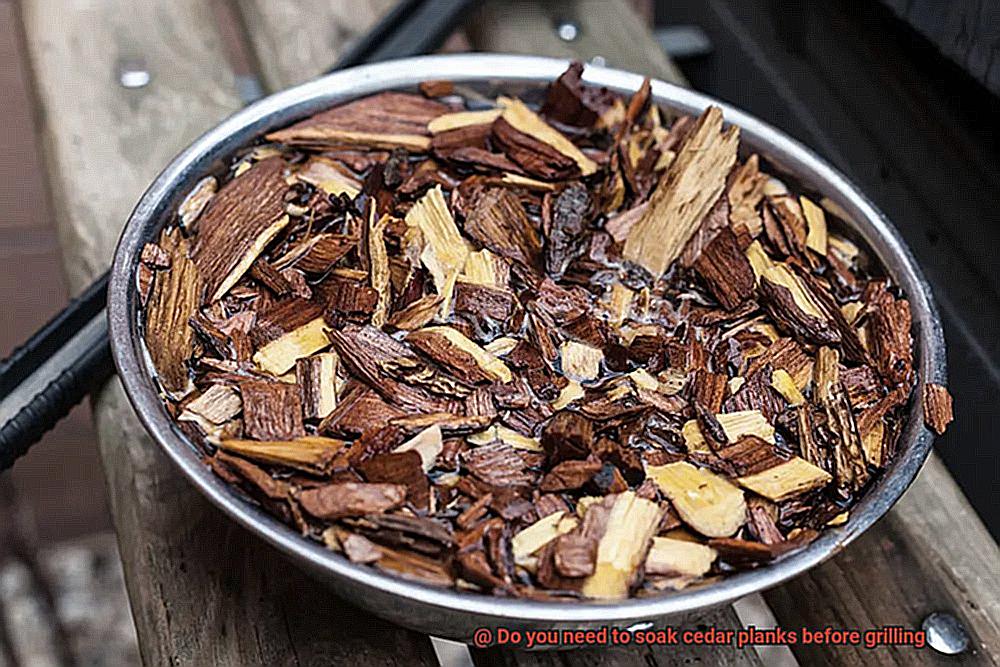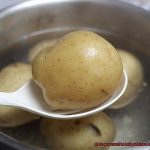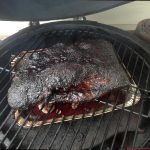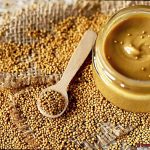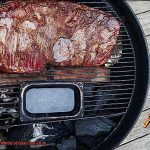Picture this: a warm summer evening, the grill is fired up, and you’re getting ready to cook up some juicy meat or fish on a cedar plank. The aroma of wood smoke fills the air, and your mouth waters in anticipation of that unique and delicious flavor. But before you get started, there’s one question that needs answering: do you need to soak cedar planks before grilling?
It’s a contentious issue, with opinions divided between those who swear by soaking and those who think it’s unnecessary. On one hand, soaking the planks for an hour or more can prevent them from catching fire and reduce the risk of acrid smoke spoiling your food. On the other hand, some argue that soaking extends cooking time and washes away oils essential for that signature cedar flavor.
So where should you stand on this hotly debated topic? In this blog post, we’ll explore both sides of the argument in detail and give our final verdict on whether or not you should soak your cedar planks before grilling. So grab a cold drink, sit back, and let’s dive into the sizzling world of cedar plank grilling.
Contents
What Are Cedar Planks?
These thin pieces of Western Red Cedar are a grilling and smoking game-changer that add an exceptional smoky flavor to seafood, vegetables, and meats. But what exactly are cedar planks and why are they used in grilling and smoking?
Cedar planks are typically around 12 inches long, 6 inches wide, and 1 inch thick, made from Western Red Cedar. This type of wood is known for its fragrant aroma and natural resistance to decay. When used in grilling or smoking, cedar planks add a unique flavor to the food being cooked. The wood’s natural oils release when heated, infusing the food with a smoky and slightly sweet taste.
Salmon lovers, listen up. One of the most popular dishes made on cedar planks is salmon. The cedar plank adds a subtle flavor that complements the salmon’s natural flavor, making it an excellent choice for seafood enthusiasts. However, cedar planks can also be used to cook other types of food, such as vegetables and meats.
Before using cedar planks on the grill, it’s essential to soak them in water for at least an hour. Soaking the planks helps prevent them from catching fire and burning on the grill. It also adds moisture to the plank, which in turn adds moisture to the food being cooked on it. For best results, some experts recommend soaking them for up to four hours to ensure they are fully hydrated and less likely to burn.
When shopping for cedar planks, it’s crucial to choose untreated cedar planks that have not been chemically treated or coated with any substances. This ensures that the wood is safe to use with food and won’t add any harmful chemicals or flavors to your dishes.
Benefits of Soaking Cedar Planks Before Grilling
Add a smoky and sweet flavor to your food by using cedar planks. Soaking cedar planks before grilling is not just a step, but a necessary one that comes with numerous benefits.
One of the most critical benefits of soaking cedar planks is preventing them from catching fire on the grill. Cedar planks are highly flammable, and they can quickly burn if they become too hot. Soaking the planks in water creates a barrier between the wood and the heat source, preventing them from igniting. No more ruined meals due to flaming cedar planks.
But wait, there’s more. Soaking cedar planks also creates a moist cooking environment that enhances the flavor of your food. As the plank heats up on the grill, it releases moisture and creates steam, which helps keep your food moist and tender while imparting a delicate smoky flavor. The result? A mouth-watering dish that will leave your taste buds begging for more.
Finally, soaking cedar planks before grilling helps extend their lifespan. Without soaking, cedar planks tend to dry out quickly and become brittle, making them more likely to break or splinter while on the grill. By keeping them moist and flexible, soaking extends their lifespan for future use and saves you money in the long run.
How to Soak Cedar Planks Before Grilling
Grilling on cedar planks is a popular technique that adds an earthy, smoky flavor to your food. However, to achieve the best results, it’s important to soak the planks in water before grilling. Here are five tips on how to soak cedar planks:
Time your soaking
Submerge the cedar planks in water for at least an hour before grilling. This allows the wood to absorb moisture and prevents it from catching fire while on the grill. Some grill masters prefer to soak their planks overnight for maximum moisture retention.
Weight down the planks
Ensure that the cedar planks are fully submerged in water and free of air pockets by using a heavy object like a ceramic plate or a large rock.
Use clean water
It’s crucial to use clean water when soaking cedar planks. If you soak the planks for more than an hour, change the water every 30 minutes to keep it free of contaminants.
Experiment with other liquids
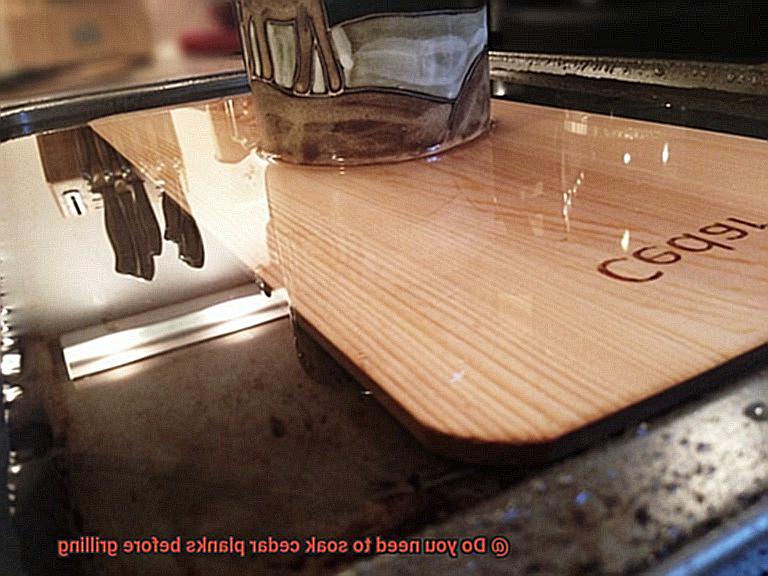
You can add an extra kick of flavor to your food by soaking cedar planks in other liquids such as wine, beer, or fruit juice. Be sure to avoid liquids containing sugar or oil as they can cause the planks to catch fire.
Pat dry before grilling
After soaking, remove the cedar planks from the water and pat them dry with a towel. This step ensures that any excess water is removed from the plank before placing it on the grill.
Safety Considerations When Grilling with Cedar Planks
Before you get started, it’s crucial to prioritize safety to ensure a delicious and safe grilling experience. As an expert in cedar plank grilling, I’ve compiled some essential safety tips that you should keep in mind when using cedar planks for grilling.
Firstly, let’s talk about smoke. Cedar planks can produce a lot of smoke when heated, which can be irritating to the eyes and lungs. To enjoy your grilled food without compromising your respiratory health, make sure to grill in a well-ventilated area or use an outdoor grill. This will not only keep the air clear but also enhance your grilling experience by letting you breathe in the tantalizing aroma of the cedar.
Another crucial safety consideration is the risk of fire. Cedar planks can ignite if they are exposed to direct flames, so it’s important to keep a watchful eye on them while grilling and prepare for any unexpected flare-ups by having a fire extinguisher nearby. To reduce the risk of fire, soak the cedar planks in water for at least an hour before grilling. This will help prevent them from catching fire and also add moisture to the food as it cooks.
Choosing high-quality cedar planks is also paramount for safe and delicious grilling. Opt for planks that are labeled as food-grade and free from any chemicals or additives that could be harmful when heated. Avoid planks that have been treated with preservatives or pesticides, which could leach into your food and pose a health risk. And after each use, make sure to clean and store your cedar planks properly to prevent any bacteria from growing on them.
Different Types of Wood for Grilling
Each type of wood has its own unique flavor profile that can greatly affect the taste of your food. Here are five reasons why you should consider the flavor profile of the wood when choosing which type of wood to use for grilling:
Wood Imparts Different Flavors
The type of wood you choose can make or break the flavor of your grilled food. For example, mesquite has an intense and smoky flavor, making it perfect for beef and pork. Meanwhile, applewood has a mild and sweet flavor that complements poultry and pork.
Wood Affects Aroma
The aroma of the wood also plays a crucial role in enhancing the flavor of your food. Hickory, for instance, has a strong and bold aroma that can give your meats a rich and savory taste.
Wood Can Enhance or Overpower Flavor
Using too much or too little wood can greatly impact the overall flavor of your food. Too much wood can overpower the natural flavor of your food, while too little may not give it enough smoky flavor.
Wood Choice Can Affect Moisture Levels
Certain types of wood, like cedar planks, can help keep your food moist during grilling. Cedar planks add moisture to the food being cooked on them, which is especially important when grilling seafood or vegetables that tend to dry out easily.
Safety Concerns
Using certain types of wood for grilling can pose safety concerns if not handled properly. For example, cedar planks should be soaked in water beforehand to prevent them from catching fire and burning on the grill.
Tips for the Best Results When Grilling with Cedar Planks
Grilling with cedar planks is a fantastic way to add a smoky flavor to your food. However, there are some tips you should keep in mind to achieve the best results.
Tip 1: Soak the Cedar Planks
Soaking cedar planks for at least an hour before grilling is crucial. This process prevents the planks from catching fire and allows them to fully saturate with water, which adds moisture to your food. You can also add wine or beer to the soaking water to infuse additional flavors.
Tip 2: Preheat the Planks
Preheating the soaked cedar planks on the grill helps create a nice sear on your food and releases a smoky aroma from the wood. Place the planks directly on the grill grates for a few minutes until they start to smoke before adding your food.
Tip 3: Adjust the Heat
Maintaining control over heat is crucial when grilling with cedar planks. Keep an eye on the planks while grilling and adjust the heat as needed. If they start to catch fire, move them away from the heat source or use a spray bottle of water to extinguish any flames.
Tip 4: Choose Food-Grade Cedar Planks
Using untreated, food-grade cedar planks is essential for safe and healthy grilling. Avoid chemically treated or stained planks that can release harmful chemicals into your food. Additionally, it’s important to use each plank only once to prevent bacteria growth and potential food contamination.
Tip 5: Experiment with Different Woods
Exploring different types of wood is encouraged when grilling with cedar planks. Hickory, cherry, and maple are great options that can add unique flavors to your food. However, make sure to research which woods are safe for grilling and cooking before trying them out.
Alternatives to Soaking Cedar Planks Before Grilling
There are several alternatives that can achieve the same great smoky flavor without any of the potential issues.
One option is to place your dry cedar plank directly on the grill grates for a few minutes before adding your food. This simple and effective method heats up the plank and reduces any potential warping.
Another alternative is to brush your dry cedar plank with olive oil before placing it on the grill. This not only prevents sticking but also adds an extra layer of flavor to your food. Who doesn’t love a little bit of healthy fats?
If you’re looking to add moisture and flavor to your food, try using a spray bottle filled with water or apple juice to spritz your dry cedar plank while it’s on the grill. This creates steam that infuses your food with deliciousness. Just remember not to soak the plank as it can cause excessive smoke production and an unpleasant taste.
For those looking to switch things up, cedar wraps are a fantastic alternative. These thin sheets of cedar can be wrapped around individual pieces of food, such as fish or vegetables. They don’t require any soaking and provide a more even cooking experience as they come into direct contact with the food.
Common Mistakes to Avoid When Grilling with Cedar Planks
If you’re looking to elevate your grilling game and add a smoky flavor to your food, using cedar planks is a great option. However, there are some common mistakes that many people make when grilling with cedar planks that can ruin the experience. As an expert in this area, I am here to help you avoid these pitfalls and create delicious and flavorful dishes.
First and foremost, it’s crucial to soak your cedar planks before grilling. Skipping this step can result in the planks catching fire, which will not only ruin your food but also pose a safety hazard. However, over-soaking the planks can also be problematic as they may become waterlogged and produce less smoke. Soaking the planks for around 1-2 hours before grilling is ideal.
Another mistake to avoid is not preheating your grill and cedar planks. Preheating is essential as it ensures that the planks are hot enough to cook your food properly and also prevents them from catching fire. To do this, turn on your grill to high heat and let it heat up for about 10-15 minutes before placing the planks on it.
Finally, don’t forget to use enough oil or seasoning on your food before placing it on the plank. Cedar planks work best with foods that have a higher fat content, such as salmon or steak. Adding oil or seasoning to your food not only prevents it from sticking but also enhances its flavor.
In summary, here are the common mistakes to avoid when grilling with cedar planks:
- Not soaking the cedar planks before grilling
- Over-soaking the cedar planks
- Not preheating the grill and cedar planks
- Not using enough oil or seasoning on your food
z_3Y9p8mTe0″ >
Conclusion
In summary, grilling on cedar planks is a fantastic way to infuse your food with a unique smoky flavor that will tantalize your taste buds. The age-old question of whether or not to soak the planks before grilling has been hotly debated among grill enthusiasts for years. However, it’s crucial to soak the cedar planks for at least an hour before grilling to prevent them from catching fire and enhance the flavor of your food.
Choosing high-quality, untreated cedar planks labeled as food-grade and free from chemicals or additives is also vital for safety reasons. Additionally, grilling in a well-ventilated area and keeping an eye on the planks while cooking are essential precautions.
Experimenting with different types of wood can significantly affect the taste of your food. Therefore, it’s essential to research which woods are safe for cooking and grilling before trying them out. If you’re looking for alternatives to soaking cedar planks, preheating them on the grill or brushing them with olive oil are excellent options.
To avoid common mistakes when using cedar planks, make sure to soak them correctly, preheat both the grill and planks, and use enough oil or seasoning on your food.

